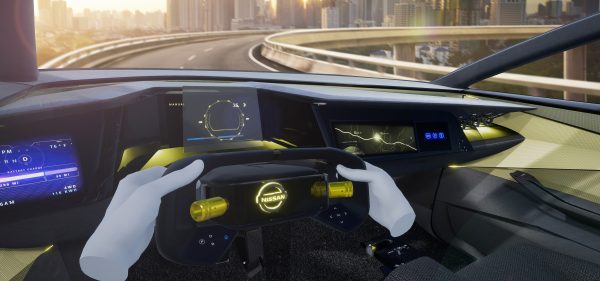Nissan Using HAPTX VR to Bring a Realistic Touch to Future Car Design
Automotive design traditionally begins with the two-dimensional sketching before the design is eventually brought to life with the full-sized clay models. It’s a very complex, technical and time-consuming task and automakers and designers are constantly looking for ways to streamline this process for a more efficient, proficient and cost-effective vehicle design.
One automaker that is trying to simplify this complex and labor-intensive process is Nissan which is exploring a high-tech design solution based on the Haptx VR gloves. These VR gloves will allow car designers to build three-dimensional car models without using clay. The HaptX Gloves enable designers to “feel” the models that they are working on and thereby modify the virtual surfaces through touch. They make it possible for the designers to work through their virtual models pretty much the same way a sculptor creating models with clay will work the surface of the material to bring out the desired look.
Nissan isn’t the first automaker to explore the use of VR in streamlining automotive design. Other automakers are already venturing into car design based on virtual reality systems and handheld controllers which now allow designers to create models within the virtual environment or to showcase finished designs in VR to auto executives and the public during car shows. HaptX says its technology will give designers even greater control over the design process than the virtual models that are already in use in the auto industry.
Nissan has teamed with HAPTX VR with the aim of enhancing the automotive design process via VR and realistic haptic feedback technology. The designers at Nissan will make use of the HaptX Gloves to touch and also interact with the 3D models virtually. With these gloves, designers can perform easy immersive design reviews that would have required costlier and time-consuming full-scale physical prototypes.

The auto industry is currently making significant investments in both virtual and augmented reality technologies with the aim of streamlining the design and manufacturing process and also ensuring better decision-making.
The widespread use of immersive technology will also reduce the need for the labor-intensive physical prototypes. The main hurdle to realizing full-scale VR design has been issues to do with touch and input. The current virtual reality controllers do not have realistic touch feedback and this makes it impossible for designers to naturally interact with their virtual models.
Nissan is partnering with HaptX to overcome these challenges and realize seamless VR design. With the HaptX Gloves, auto designers are able to feel the model as they design and this allows them to rapidly generate new iterations using haptic prototyping as opposed to physical prototyping. This innovation could radically revolutionize the vehicle design process and save automakers a lot of time and money.
According to HaptX, the gloves provide designers with plenty more benefits beyond the mere seamless and cost-effective design. Using the gloves, designers and other users can go further and grip the steering wheel of the models or even turn on the volume knobs in the virtual models. These kinds of features give the models an extra layer of realism that can never be realized with the clay models. However, it is not yet known how accurately the HaptX gloves will convey the various variables involved in the vehicle design such as the feel of the disparate materials used in the design or certain actions in the car.
Nissan is the first Japanese automaker to deploy the HaptX Gloves in automotive design. To date, the automaker has already made various car designs that can be touched with HaptX Gloves such as the Nissan Leaf -which is currently the best selling highway-capable electric car in the world – and the Nissan IMS, a fully-electrified luxury sports sedan concept car that was exhibited at the NAIAS at the beginning of the year. HaptX has however not explicitly specified whether its technology was used in the initial design of these models.
https://virtualrealitytimes.com/2019/03/12/nissan-using-haptx-vr-to-bring-a-realistic-touch-to-future-car-design/https://virtualrealitytimes.com/wp-content/uploads/2019/03/Nissan-Partners-with-HaptX-to-Bring-Realistic-Touch-in-Virtual-Reality-Vehicle-Design-600x281.jpghttps://virtualrealitytimes.com/wp-content/uploads/2019/03/Nissan-Partners-with-HaptX-to-Bring-Realistic-Touch-in-Virtual-Reality-Vehicle-Design-150x90.jpgHapticsHardwareAutomotive design traditionally begins with the two-dimensional sketching before the design is eventually brought to life with the full-sized clay models. It’s a very complex, technical and time-consuming task and automakers and designers are constantly looking for ways to streamline this process for a more efficient, proficient and cost-effective...Sam OchanjiSam Ochanji[email protected]EditorVirtual Reality Times - Metaverse & VR
